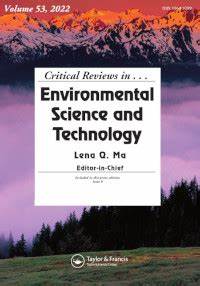全面了解客体化合物嵌入层状双氢氧化物:在去除潜在有毒元素中的设计和应用
IF 11.4
1区 环境科学与生态学
Q1 ENVIRONMENTAL SCIENCES
Critical Reviews in Environmental Science and Technology
Pub Date : 2022-06-07
DOI:10.1080/10643389.2022.2070402
引用次数: 2
摘要
层状双氢氧化物(LDHs)及其衍生材料作为一种潜在的工程吸附剂,在水环境保护中具有重要的应用前景。特别是,与传统的层间阴离子(如Cl−、SO4 2−、NO3−、co32−和PO4 3−)不同,嵌入不同客体化合物的LDHs (GC-LDHs)在最近的研究中被广泛报道,显示出它们在水净化中的多功能作用。本文系统介绍了GC-LDHs的合成方法和表征技术,以及它们作为吸附剂在去除水相中潜在有毒元素(pte)方面的应用。综述了络合、螯合、沉淀、同构取代和离子交换在GC-LDHs去除PTE过程中的重要作用。其中,与PTE阳离子相比,离子交换是GC-LDHs去除PTE氧离子的另一种机制。此外,还总结了pH、离子强度、温度、原始LDHs和客体化合物的理化性质对GC-LDHs吸附性能的影响。最后,提出了GC-LDHs的发展趋势和未来挑战。图形抽象本文章由计算机程序翻译,如有差异,请以英文原文为准。
Comprehensive understanding of guest compound intercalated layered double hydroxides: Design and applications in removal of potentially toxic elements
Abstract Layered double hydroxides (LDHs) and LDHs-derived materials are emerging as potential engineered adsorbents for the protection of water environment. Particularly, LDHs intercalated with different guest compounds (GC-LDHs), which differ from traditional interlayer anions (such as Cl−, SO4 2−, NO3 −, CO3 2−, and PO4 3−), are widely reported by recent studies showing their promising multifunctional roles in water purification. Herein, this review systematically presents the synthesis methods and characterization techniques of GC-LDHs and their application as adsorbents in removing potentially toxic elements (PTEs) from the aqueous phase. This review also elaborates on the important roles of complexation, chelation, precipitation, isomorphic substitution, and ion exchange in the process of PTE removal by GC-LDHs. Among them, compared with PTE cations, ion exchange is an additional mechanism for the removal of PTE oxyanions by GC-LDHs. Furthermore, the influence of pH, ionic strength, temperature, physiochemical properties of original LDHs and guest compounds on the GC-LDHs adsorption performance are also summarized. Finally, the development trends and future challenges related to GC-LDHs are proposed. Graphical abstract
求助全文
通过发布文献求助,成功后即可免费获取论文全文。
去求助
来源期刊
CiteScore
27.30
自引率
1.60%
发文量
64
审稿时长
2 months
期刊介绍:
Two of the most pressing global challenges of our era involve understanding and addressing the multitude of environmental problems we face. In order to tackle them effectively, it is essential to devise logical strategies and methods for their control. Critical Reviews in Environmental Science and Technology serves as a valuable international platform for the comprehensive assessment of current knowledge across a wide range of environmental science topics.
Environmental science is a field that encompasses the intricate and fluid interactions between various scientific disciplines. These include earth and agricultural sciences, chemistry, biology, medicine, and engineering. Furthermore, new disciplines such as environmental toxicology and risk assessment have emerged in response to the increasing complexity of environmental challenges.
The purpose of Critical Reviews in Environmental Science and Technology is to provide a space for critical analysis and evaluation of existing knowledge in environmental science. By doing so, it encourages the advancement of our understanding and the development of effective solutions. This journal plays a crucial role in fostering international cooperation and collaboration in addressing the pressing environmental issues of our time.

 求助内容:
求助内容: 应助结果提醒方式:
应助结果提醒方式:


